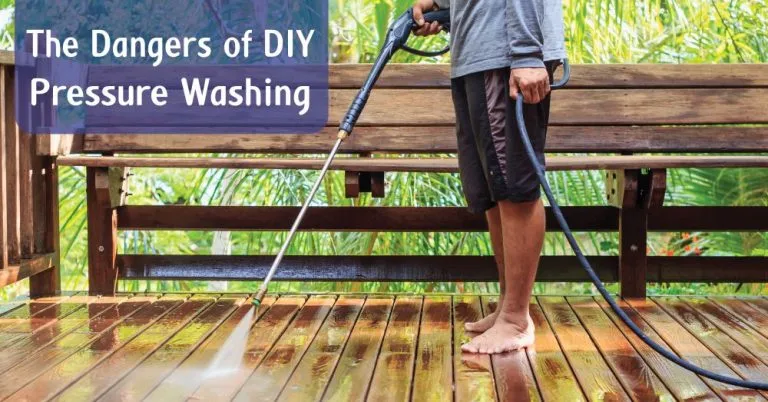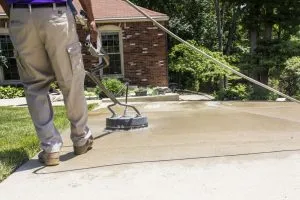
Pressure washers have become extremely popular rental options among homeowners looking for fast and efficient cleans. Pressure washing your siding, deck, and driveway is extremely effective if done correctly. Unfortunately, many are unaware that there are different types of equipment meant for different surfaces… and that without proper training, one can easily damage their property.
The most common mistake do-it-yourself pressure washers will run into is applying too much pressure. It is easy to underestimate the power of a jet of water, but many first-time attempts will end up carving strips out of wood decking or etching lines into the home’s siding.
Many DIY pressure washers also only load their washer with water. Without the proper ratio of cleaning solution mixed in, your cleaning effectiveness will be significantly reduced, and probably lead you to apply too much pressure to make up for lost power. Water-only mixtures also spread mold spores around. The extra pressure and mold-related damages can cost you big money.
There’s an art to a thorough house clean. It is difficult to prescribe any single technique because of the huge variance between pressure washer models, but there are some general guidelines that we can share:
- Always start with a wider fan pattern, and keep the nozzle moving. Always hold it at the distance recommended in your user manual. Avoid blasting directly into corners, beneath the lip of a window, or into dryer and attic vents.
- We recommend pressure washing FIRST if you plan to also do the windows. Though not nearly as damaging or permanent a problem, cleaning out of order will essentially make your cleaning effort worthless, so that the cost of your rental is paid for nothing. If you clean your windows first and then try to pressure wash, you will end up bathing your sparkling windows in dirt and grimy residue.
- Mind electrical hazards. Ensure that electric pressure washers are properly connected and grounded at all times. Also, beware of shock hazards around the house, and make sure that you are wearing rubber-soled shoes for extra protection.
Many homeowners will find that once the cost of rental, transport to and from the rental location, and a wasted day’s effort are factored together, they would have been better off investing in a Window Genie house pressure washing service. When first-timers try and fail with DIY attempts, this cost-effectiveness ratio is skewed even more, so that they end up paying big repair money for what was a long, hard day that produced a sub-par clean.

If you’re still interested in going the DIY route, make sure you do your research and get the right equipment. Don’t be afraid to ask questions about pressure washing or request a demo/training. You can find pressure washers in many different places. Big-box department stores carry cheap models, while hardware stores typically have higher-quality versions available. Garage sales, rental shops, and family equipment loans are the most common ways that people get their hands on their first pressure washer, and that can be a problem. Outdated or unregulated models could pose a safety hazard both to you and your vinyl siding. Try to find models with modern safety features such as quick-release triggers, warning labels, ground-fault circuit interrupters, temperature control switches, unloader valves, back-flow protection, rupture disks, and thermal overload motor protection. If your model lacks any of these, look elsewhere.
To learn more about pressure washing, visit us online or call your local Genie today.
